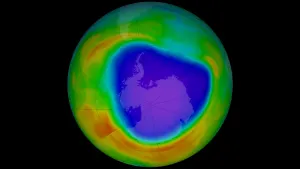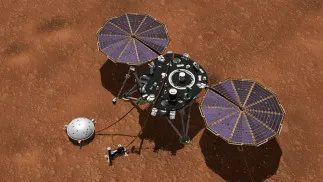
NASA InSight is now beaming daily weather reports from Mars!
Weather nerds, rejoice! NASA's InSight lander is now streaming daily weather data from Mars, along with a few mysteries for scientists to unravel.
NASA's newest interplanetary robot, InSight, touched down on the Red Planet on November 26, 2018.
Its primary mission: to unveil the inner workings of Mars, by listening for tremors known as 'marsquakes', by drilling down to take the planet's temperature, and by measuring the 'wobble' of the planet's poles.
Another important part of the mission, though, is InSight's weather station, which continuously monitors atmospheric conditions - temperature, pressure and wind - at the lander's location.
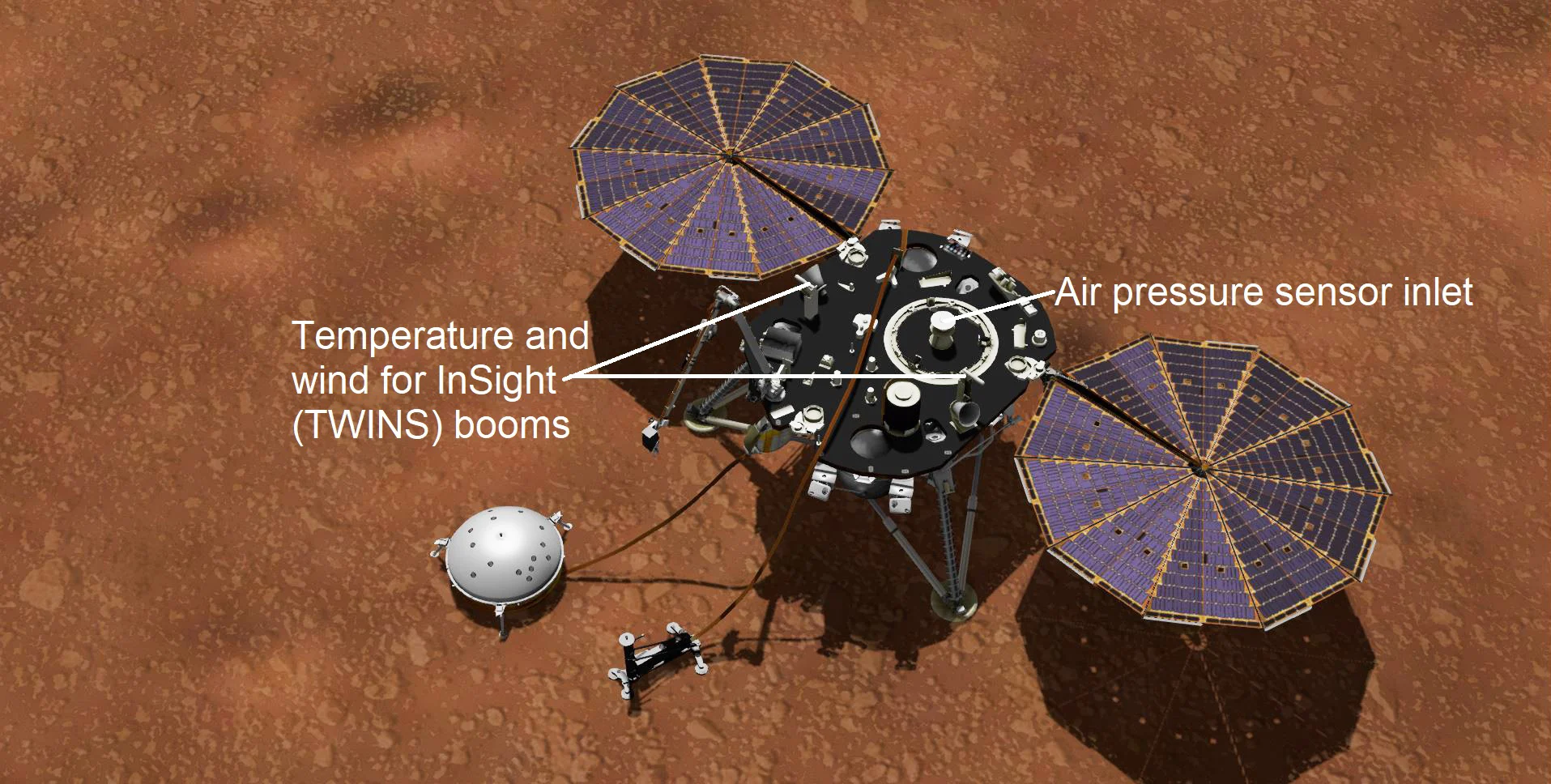
This artist's impression of the InSight lander on Mars points out the instruments that are part of the robot's weather station - the TWINS temperature and wind sensors, and the pressure sensor inlet. Credit: NASA/JPL-Caltech
The two TWINS - Temperature and Winds for InSight - sensors are attached to short booms, on either side of the lander deck, one pointing out over the left solar panel, and the other over the right solar panel. There are two of them because the wind sensors work best when the winds are coming at the sensor, head on, so both are needed for sufficient coverage of the rover's environment. The pressure sensor was housed underneath InSight's Wind and Thermal Shield (WTS), until the small white dome was removed and placed on the ground, to shield the lander's seismometer.
This instrument package, overall, is mainly there to support the rest of the mission, by supplying the scientists with weather data so they can account for atmospheric effects during their search for marsquakes. It is also, however, the best weather station we have ever landed on the surface of Mars.
Why is that important?
To find out, we spoke with Don Banfield, a researcher at Cornell University who is the principle investigator of InSight's weather station.
According to Banfield, other than the much lower air pressure on Mars and much colder temperatures, overall, the atmospheric processes on Earth and Mars are roughly the same, except for one key difference.
While water is extremely important for Earth's weather systems, especially due to the uptake and release of heat that comes from evaporation and condensation (ie: 'latent heat'), there is very little water vapour in Mars' atmosphere.
"On Mars, we do have a little bit of clouds, but they really don't drive the dynamics very much," Banfield says. "What does, on Mars, is dust."
"Dust, when it is lofted into the atmosphere on Mars, can dramatically change the heating of the ground, and the heat that is deposited into the atmosphere," Banfield explained. "It does not have the latent heat effects that water does, by condensing and evaporating, but it still impacts where the sunlight is absorbed, depending on whether it is in the atmosphere or not, and it changes the infrared opacity of the atmosphere, too, so the ground cannot cool down as much at night."
"One thing we do not yet have a great grasp on, for Mars, is what it takes to actually lift that dust up."
According to Banfield, scientists have recorded all different levels of dust storms, from local to regional to global, and they've seen dust devils swirling across the ground, but they still don't know the exact wind speeds that are required to lift dust off the ground and loft it into the air.
Watch below to see dust devils captured by NASA's Curiosity rover
The Curiosity rover was equipped with two wind sensors - the exact same instruments that are currently on InSight - when it launched. One of them broke, however, likely during landing, making wind measurements unreliable right from the start of the mission. The other broke roughly three years later, cutting off all wind measurements from the rover. Thus, even though the rover experienced dust storms and dust devils, it couldn't collect data to give scientists an idea of the winds that accompanied these events.
With InSight's weather station continuously monitoring the weather conditions at Elysium Planitia, and its cameras recording the environment around the lander, the hope is that it can sit through one or more of these dust events, or see dust devils passing by, while recording the weather and snapping pictures, so that scientists here on Earth can get a good idea of what it takes.
Additionally, Banfield says that InSight could also provide researchers with the 'saltation' wind speed on Mars, which is the speed of the winds necessary to move larger sand particles around on the surface.
Images from orbiters and rovers have shown us that sand dunes certainly do migrate on Mars, but they have never been recorded in the process of moving, nor have there ever been accurate wind speeds recorded that show what it took to cause them to migrate.
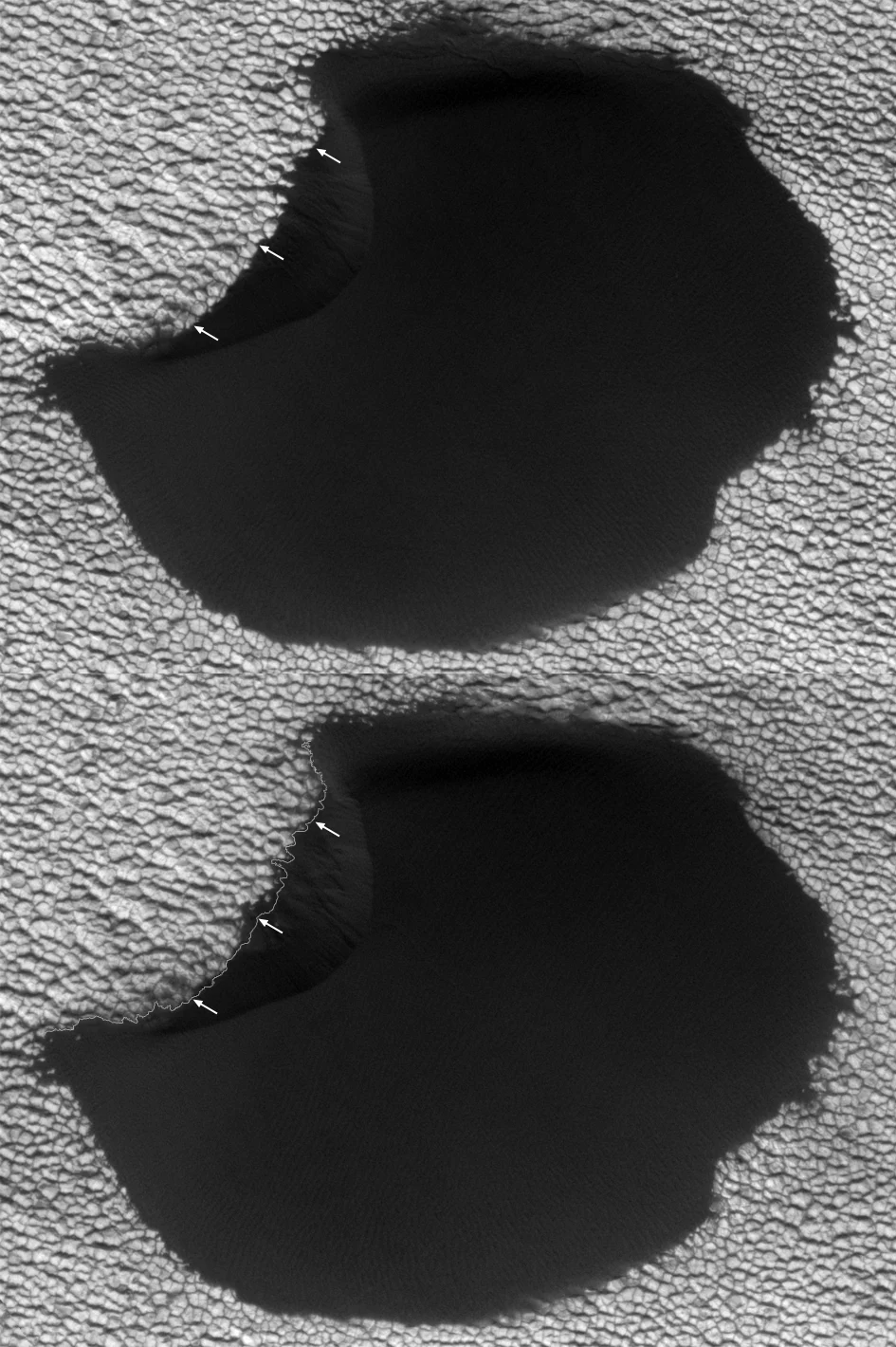
NASA's Mars Reconnaissance Orbiter captured the two images of this north polar sand dune, on June 25, 2008 (top) and May 21, 2010 (bottom), which shows the dune has moved in the time between the two shots. The dune is advancing towards the upper left of the image. The thin white line along the leading edge of the dune, in the lower image, notes the position of the leading edge in the top image. Credit: NASA/JPL-Caltech/Univ. of Ariz./JHUAPL
SURPRISES AND MYSTERIES
InSight has only been on the surface of Mars for a few months now, and its pressure sensor has only been exposed to the environment for a few weeks, but the lander's weather station is already sending back data that is raising some eyebrows amongst the mission scientists, and giving them a mystery or two to solve.
The first surprise comes from InSight's pressure sensor. This instrument is extremely sensitive, and while it has been recording the daily pressure variations on the planet - increasing overnight, while the atmosphere cools and contracts, and decreasing during the day, as the atmosphere warms and expands - it has also been registering a smaller and slower variation from a different source.
"If you look at the pressure signal and carefully remove the diurnal variation, you see a 2 or 2.5 day oscillation," Banfield said. "That is exactly coincident with the travelling baroclinic waves we see on the polar vortex in the northern hemisphere."
Baroclinic waves are, essentially, the same thing we see here on Earth as high and low pressure systems travel around the planet.
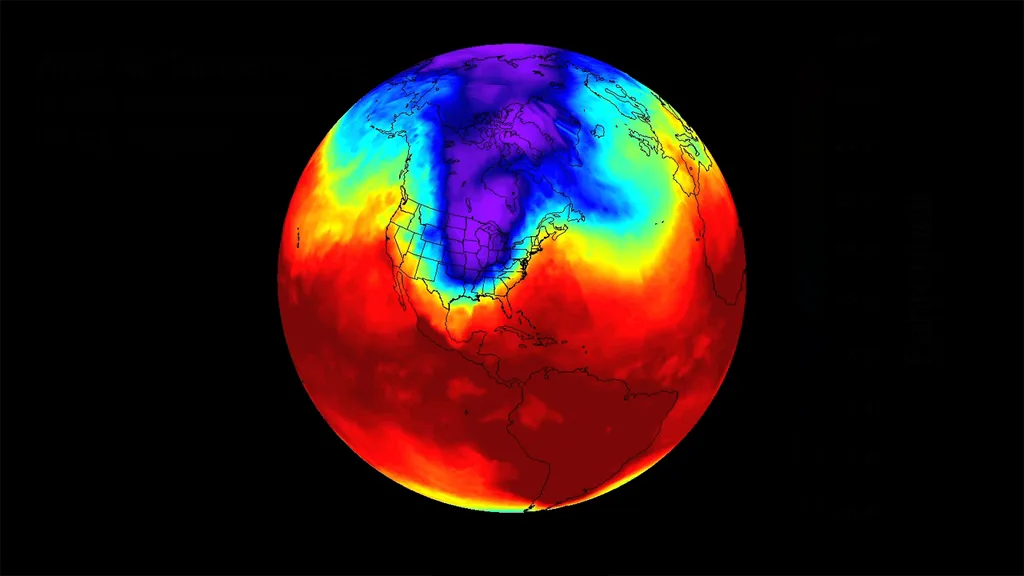
Temperature records from a NASA satellite, taken on Jan. 6, 2014, shows an outbreak of the 'polar vortex' that caused frigid temperatures across the eastern half of the United States and Canada. This lobe of the polar vortex is analogous to a baroclinic wave. If InSight were placed on the globe, however, it would be far to the south of this wave, in the northern part of South America. Credit: NASA/JPL
What's surprising about this, according to Banfield, is that InSight is in Mars' tropics, at around 4°N, and on Earth, you don't see surface baroclinic waves reaching all the way down from the poles to the tropics. Waves much higher up in the atmosphere are capable of reaching that far from the poles, but you don't see it at the surface.
"I'm a bit surprised by that," says Banfield, "that we can see the pressure signal that far south. I really didn't expect that."
The second surprise (and a bit of a mystery) also comes from the pressure sensor, in the form of what appears to be an 'infrasound' event.
Infrasound is low frequency, long wavelength sound waves, below the range of human hearing, passing through the air.
On Mars, Banfield says, sound in the human range of hearing doesn't travel very well through the thin atmosphere, but infrasound travels just as well as it does here on Earth.
The cause of this signal is currently unknown, but there's one possibility.
"If there was a meteor impact, maybe a few hundred kilometres away, it would presumably make some infrasound, like the Chelyabinsk impact did, and maybe we're picking that up," says Banfield.

This intense bolide explosion lit up he dawn sky over Chelyabinsk, Russia on February 15, 2013, as a massive asteroid plunged into the atmosphere. The event was recorded by dashcam. Credit: Aleksandr Ivanov/Wikimedia Commons (CC BY 3.0)
The Chelyabinsk impact was a 20 metre-wide, roughly 12 kiloton asteroid that exploded over the Russian city of Chelyabinsk, on February 15, 2013. The event set off infrasound waves through the atmosphere that were recorded up to thousands of kilometres away from the impact site.
For the final mystery, at least at the moment, Banfield and his team have noticed some unusual changes in the pressure data, both in the evening and in the morning.
Based on what we know of atmospheric pressure on Mars, the data should follow a very smooth, gradual curve, peaking overnight as the air cools, and bottoming out late in the day, as the air warms and there is more convective mixing.
Every evening, around 7 p.m., however, what should be a very smooth curve in the graph suddenly experiences a slight bump, followed by a flattening out of the slope, and then it resumes its gradual rise. In the morning, around 7 a.m., there's a sudden peak in pressure, and then it goes back to the gradual decrease throughout the day.
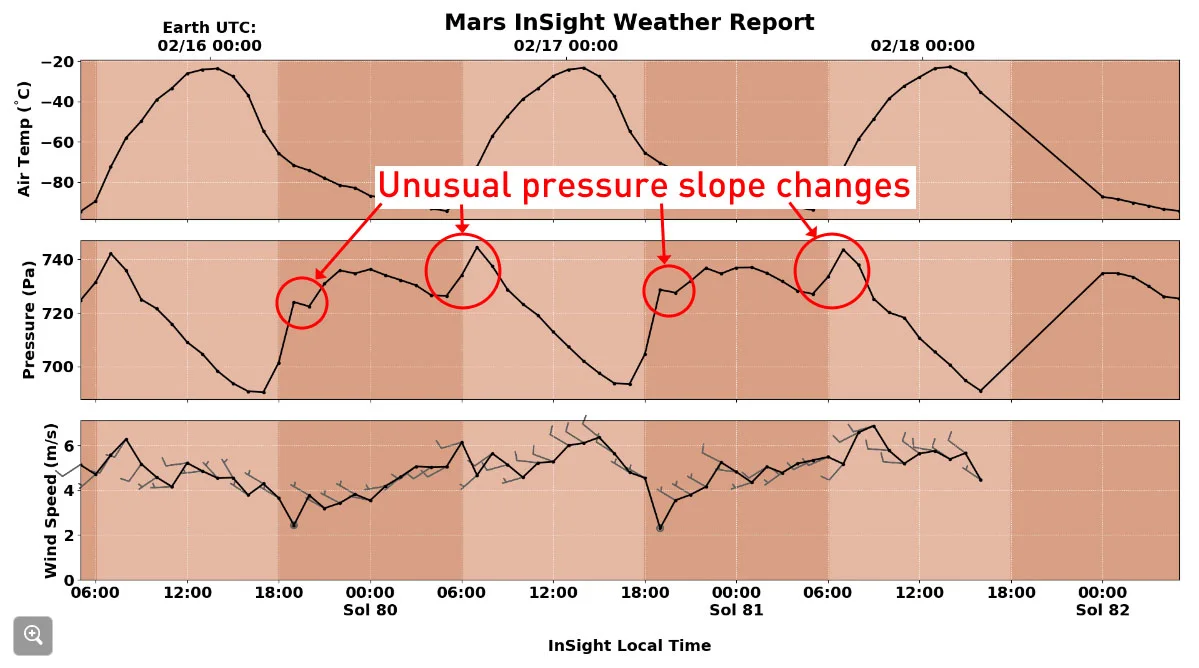
This view of the InSight weather records shows unusual breaks in the gradual pressure changes seen by the lander's instrument. Credit: NASA/Scott Sutherland
According to Banfield, the team has investigated whether this is being caused by the instrument itself, and he is confident that what they're seeing is really happening in the environment. It's just that there's no explanation, as of yet, for what's actually causing it.
"It's a puzzle," Banfield says. "It's telling us that Mars is a little more complex than the atmospheric models can quite yet represent. Hopefully, we can learn something interesting when we diagnose exactly what it is."
FOR THE WEATHER NERDS
Not only is InSight's weather data available for the scientists to peruse, it's available to the public, as well.
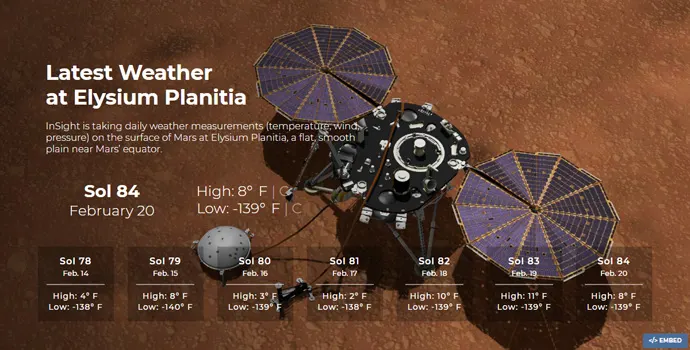
This view of the InSight weather page was taken on mission Sol 84 (February 20, 2019). The page updates on a regular basis with new data, as well as data in tabular and graph formats. Follow the link, below, for the most up-to-date data. Credit: NASA/JPL-Caltech/Cornell/CAB
So, anyone who wants to see what the weather conditions are on Mars - at least at InSight's location at Elysium Planitia - can visit the website any time to check it out.
"I would say the one takeaway I was hoping that would come out of this press release is that the people who are serious weather nerds find that website, and just keep looking at it as time goes on," says Banfield. "I think it will be interesting to see, in the same way we look at weather on Earth, how it evolves on Mars."
"There's all different levels of enthusiasm for weather," he added, "and I think [this site] caters to both the very casual observer, and some of the more serious weather nerds."
Check out the Latest Weather at Elysium Planitia!
Source: NASA JPL | With thanks to Don Banfield








